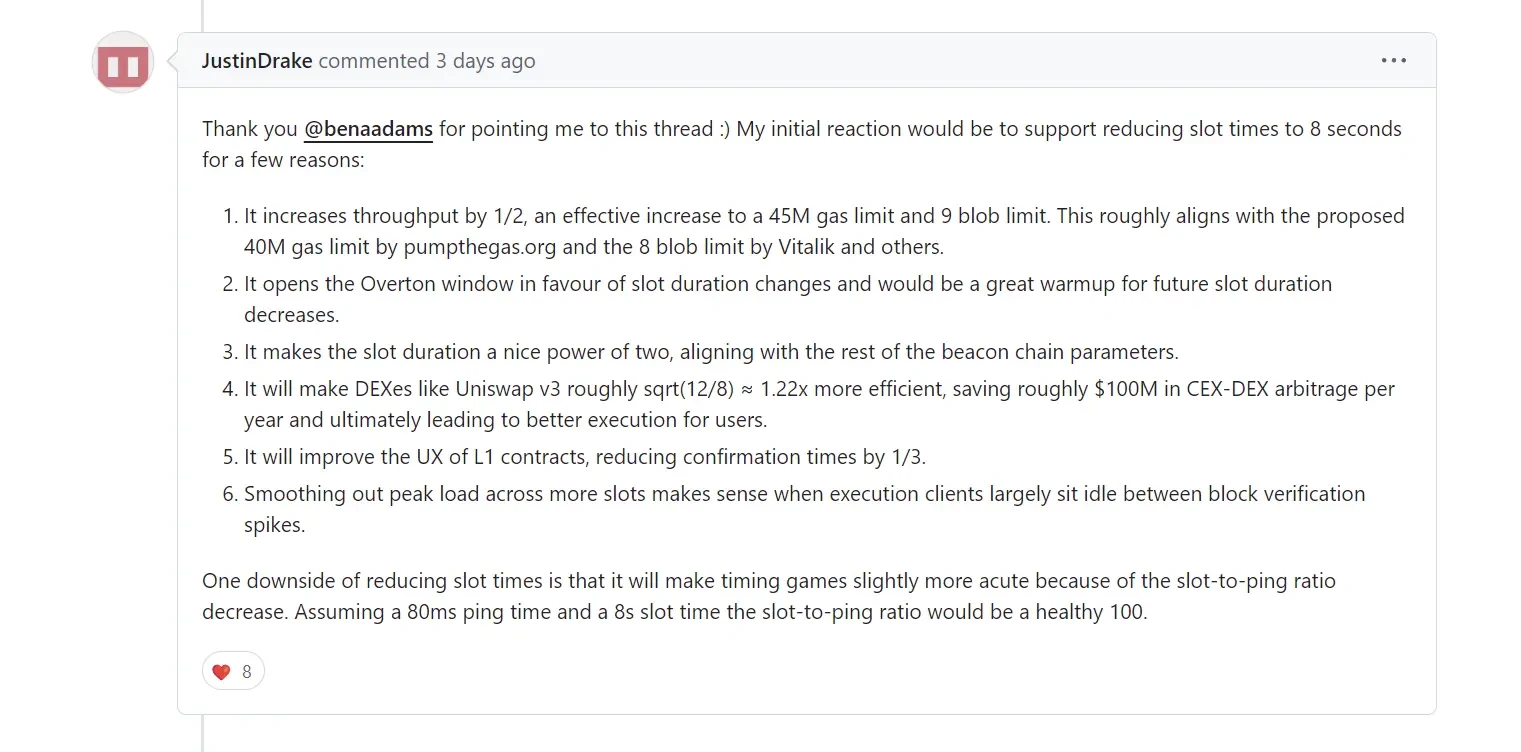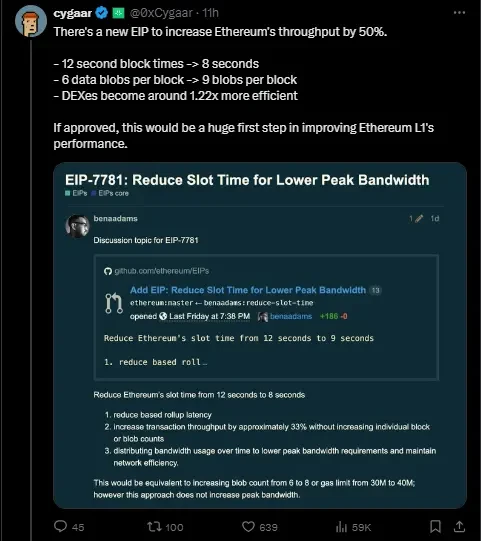Original author: Scof, ChainCatcher
原文编辑:年青、ChainCatcher
Recently, a new improvement proposal (EIP) in the Ethereum community has sparked discussion. The new EIP-7781 proposal aims to increase the overall throughput of the Ethereum network by shortening block times and increasing data processing capacity. This proposal was proposed by Ben Adams, co-founder of Illyriad Games, on October 5. In simple terms, it will shorten the block generation time from 12 seconds to 8 seconds, increase the data processing volume of the block, and increase the throughput by 50%. In addition, it also plans to reduce the fees of the Ethereum Layer 2 network by increasing rollup-based delays.
Ben Adams described EIP-7781 as increasing transaction throughput by about 33% without increasing the number of individual blocks or blobs; distributing bandwidth usage over time to reduce peak bandwidth requirements and maintain network efficiency; this is equivalent to increasing the number of blobs from 6 to 8, or increasing the gas limit from 30M to 40M; but this approach does not increase peak bandwidth.
Justin Drake, a researcher at the Ethereum Foundation, supports this proposal. He believes that shortening the slot time to 8 seconds will significantly improve the overall performance and user experience of the network. This change will not only increase network throughput by 50%, improve the efficiency of de-DEX (such as Uniswap v3), and save about $100 million in CEX-DEX arbitrage costs each year, but also optimize the user experience of Layer 1 smart contracts by shortening the confirmation time by one-third. At the same time, reducing the slot time can better distribute peak loads, making the resource utilization of the executing client more balanced during non-verification peak periods, which is in line with Ethereums long-term expansion goals. Despite the risk of intensified time games, Justin Drake believes that this change is a key step towards a more efficient and scalable network.

Source: https://github.com/ethereum/EIPs/pull/8931
Currently, discussions on EIP-7781 focus on the balance between efficiency improvement and decentralization.
Shortening block times and increasing throughput will obviously improve the user experience, but this may also increase the risk of network centralization. As Web3 researcher Vikram pointed out, verification nodes will face higher hardware and bandwidth requirements, which may make it difficult for individual stakers, especially those who run nodes independently, to keep up with the development of the network. Increasing hardware requirements will weaken the decentralized nature of the network, especially in the Ethereum network, where decentralization and decentralization have always been one of its core advantages. If the entry threshold for stakers is raised, small or individual stakers may exit the network, resulting in more verification rights being concentrated in large institutions. This centralization will go against the original intention of Ethereum, making Ethereums trust model more dependent on a few nodes. Adam Cochran, partner at Cinnehaim Ventures, pointed out that while the proposal seems reasonable, further testing is needed to ensure that it does not have a negative impact on investors working from home.
However, supporters of EIP-7781 believe that although there will be certain hardware requirements, these will not seriously affect decentralization. Vitalik also recently proposed to reduce the staking threshold from 36 ETH to 16 or 24 ETH, which may attract more individuals to participate in staking. At the same time, the proposal can better balance the bandwidth usage of the network and reduce the load pressure during peak hours. In addition, this proposal also means that Ethereum has made more far-reaching considerations for the underlying expansion of Layer 1, while Layer 2 expansion solutions will continue to develop. Therefore, the implementation of EIP-7781 is not only an optimization of the performance of the existing network, but also paves the way for future expansion. Anonymous developer Cygaar called the proposal the first major move to improve Ethereums base layer in an article on X. While most of the development focus has been on Ethereums Layer 2 expansion solutions, this upgrade solves the efficiency problem of the core network.

Overall, EIP-7781 is not only a key step for Ethereum to improve performance, but also needs to consider its long-term impact on network decentralization. If this proposal can be successfully implemented, it will make the Ethereum network more competitive, especially in application scenarios such as DeFi and smart contracts. As of press time, ETH is trading at $2,445, up 1.08% in the past 24 hours.
This article is sourced from the internet: EIP-7781: Increase Ethereum throughput by 50%
原文作者:Hootie Rashidifard 原文翻译:TechFlow 目前,私人加密 VC 情绪是 2022 年第四季度以来最差的。在我们进入今年最后的融资冲刺之际,以下是一些关于当前形势以及未来关注点的想法。 过去一个季度,协议平均估值大幅下降。种子前估值现在稳定在 $10 百万至 $20 百万之间,而种子期估值在 $20 百万至 $30 百万之间。这些估值水平与 2024 年第一季度形成鲜明对比,当时估值几乎是今天的两倍。 那么,是什么导致了这种情况? 风险投资短缺 持有资金的 VC 变得谨慎 风险币在公开市场表现不佳 投资者认为缺乏创新 选举带来重大风险……







